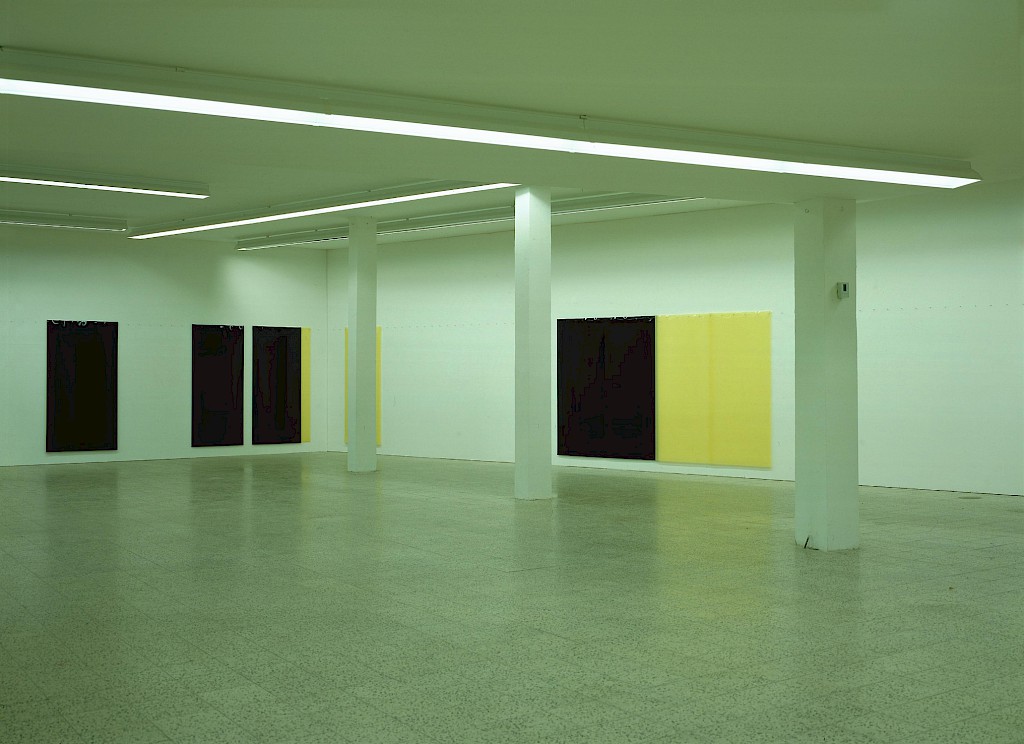Bilder
1994 | 1995
6 sheets pvc-natural, 6 sheets pvc-black
each sheet 225 x 100 x 0,5 cm
Installation in der Kunsthalle am Hochstadenring, Bonn
Installation in der Städtischen Galerie im Museum Folkwang Essen
Installation in Neuer Kunstverein Aschaffenburg
Installation in der Staatsgalerie Moderner Kunst München
The given is 12 sheets of PVC, six of them black, six further ones in the typically PVC-Yellow tones, which the artist refers to as "natural" for this reason. Each sheet measures 225 x 10O x 0.5 cm. Another given is a continuing series of nails along the walls of the exhibition halls and museums, upon which the sheets could be respectively hung, each differently - next to one another, overlapping, or on top of each other. From out of a crystal-clear basic disposition there emerges a potentially incalculable multitude of possibilities for variation. This working principlc not only applies to this installation, but also characterizes the artist's approach in general. Whereby the concern - and this is significant for Werner Haypeter's attitude as well - is precisely not for thinking through all the possibilities, once a principle has been developed. Instead of exhaustive, systematic redundancy, the artist aims for a paradigmatic choice, for introducing examples as possibilities, which may then be thought out further by the viewer. Likewise, this is his approach at the various exhibition locations cited above. By shoving together black and yellow sheets, overlapping them in part or completety, as well as by hanging individual sheets in isolation, an at once stringent and yet rhythmic process comes about, which in all cases not only fathoms the fundamental variations within the twelve sheets, but also reacts at the same time in a similar fashion to the context of the room where the work hangs. The most radical and aesthetically most daring example is his work for the Staatsgalerie in Munich. What may be seen here, at any rate when fleetingly gazing at the catalogue illustrations, are a mere two naturally colored sheets and two black sheets, affixed in axial symmetry at the left and right of the middle, which remains free.
In reality, however, the artist has layered the sheets over one another in the following order: Two light sheets over two black sheets, a single light sheet, a light sheet beneath two black sheets, and two black sheets above two light sheets. The concern is both for the picture, which is simultaneously a corporeal object, and for the surface, which takes on space and yet never entirely loses its reference to two dimensionality. There is also a concern for the subtle interplay between corporeal presence and meditative reduction, between interaction with the room and self-reference. The space becomes interpretable as a volume of picture surfaces layered x number of times, and the picture displays its dependence on spatial disposition. And the creation of various color echoes is no longer bound to the artist's more-or-less auratic act of production, but is rather a question of the arrangement of the material he has at his disposal. The picture becomes a modular disposition. As a display it comments on the context in which it stands, influencing it and being influenced by it at the same time. While this happens the effect of what we see extends beyond what had been completed in the action of creating the situation: The black sheets lying beneath the two light sheets shine through the bright yellow tone in an almost spectral manner, imbuing depth to the ensemble, something which did not seem imaginable by the simple act of layering. On the other hand, the two black sheets are apparently not changed in color at all by the yellow sheets shoved beneath them, unless you look at them from the side and discover the yellow edges shining behind the black ones: A multitude of painterly possibilities produced solely from the austere and simple facture of the industrial material, as well as orchestrated to from a setting, which comes across as at once succinct and auratic, as cool and yet exuding an inner warmth, as static and at the same time loaded with a potential movement thereby deeply influencing the surrounding space.
[Text: Stephan Berg: Ordnung und Offenheit in: »RÄUMEN. UWE SCHRÖDER WERNER HAYPETER LUTZ FRITSCH«. Ed. Gisela Clement. 2010 Weidle Verlag. Translated by Marion Read, Elizabeth Volk]





